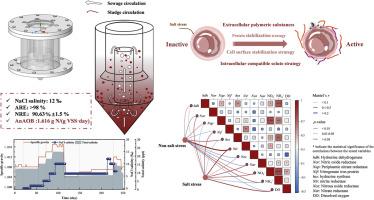Adaptation of microbial gene polymorphisms of the partial nitritation-anammox process for maintaining denitrification performance and robustness under salinity stress
IF 6.3
2区 环境科学与生态学
Q1 ENVIRONMENTAL SCIENCES
引用次数: 0
Abstract
To explore the adaptive mechanisms of the partial nitritation-anammox (PNA) process under high salinity stress during kitchen wastewater treatment, focusing on their physiological and molecular responses through metagenomic analysis. An airlift inner-circulation partition bioreactor (AIPBR) was developed, featuring an inner cylinder and a flow guide tube to create distinct oxygen gradients, facilitating the study of microbial adaptation under varying salt conditions. The AIPBR was operated with synthetic wastewater containing ammonium concentrations of 1800 ± 100 mg/L and salinity gradients ranging from 1 to 10 g/L, followed by a fixed salinity period at 6 g/L, with ammonium concentrations approximately 850 mg/L. High-throughput metagenomic analysis revealed shifts in functional genes and metabolic pathways in response to salinity stress. Anammox bacteria adapted by enriching genes involved in the synthesis of osmoprotective compounds and activating energy-producing pathways like the tricarboxylic acid cycle (TCA). These adaptations, along with modifications in membrane composition, were essential for sustaining system stability under elevated salinity. Under prolonged high salinity stress, anaerobic ammonium oxidizing (AnAOB) exhibited improved salt tolerance, maintaining a total nitrogen removal efficiency above 85 % and stabilizing after an adaptation phase. The metagenomic data revealed a marked enrichment of genes associated with ion transport, stress response mechanisms, and DNA repair pathways. Changes in microbial community composition favored salt-tolerant species, supporting system stability. These findings highlight the applicability of the developed bioreactor for scaling up the PNA process to handle high-salinity wastewater, providing a promising avenue for sustainable nitrogen removal in challenging environments.

部分硝化-厌氧氨氧化过程微生物基因多态性对维持盐度胁迫下反硝化性能和稳健性的适应性研究
探讨厨房污水处理过程中部分亚硝化-厌氧氨氧化(PNA)过程在高盐度胁迫下的适应机制,通过宏基因组分析重点研究其生理和分子响应。研制了一种气升式内循环分区生物反应器(AIPBR),该反应器具有内筒和导流管,可产生不同的氧梯度,便于研究微生物在不同盐条件下的适应性。AIPBR在含氨浓度为1800±100 mg/L,盐度梯度为1 ~ 10 g/L的合成废水中运行,然后在6 g/L的固定盐度周期内运行,铵浓度约为850 mg/L。高通量宏基因组分析揭示了盐胁迫下功能基因和代谢途径的变化。厌氧氨氧化菌通过富集参与渗透保护化合物合成的基因和激活三羧酸循环(TCA)等能量产生途径来适应。这些适应性,以及膜组成的改变,对于维持系统在高盐度下的稳定性至关重要。在长时间高盐胁迫下,厌氧氨氧化(AnAOB)表现出更好的耐盐性,总氮去除率保持在85%以上,并在适应阶段后趋于稳定。宏基因组数据显示,与离子转运、应激反应机制和DNA修复途径相关的基因显著富集。微生物群落组成的变化有利于耐盐物种,支持系统稳定性。这些发现突出了所开发的生物反应器在扩大PNA工艺处理高盐度废水方面的适用性,为在具有挑战性的环境中可持续脱氮提供了一条有希望的途径。
本文章由计算机程序翻译,如有差异,请以英文原文为准。
求助全文
约1分钟内获得全文
求助全文
来源期刊

Journal of Environmental Sciences-china
环境科学-环境科学
CiteScore
13.70
自引率
0.00%
发文量
6354
审稿时长
2.6 months
期刊介绍:
The Journal of Environmental Sciences is an international journal started in 1989. The journal is devoted to publish original, peer-reviewed research papers on main aspects of environmental sciences, such as environmental chemistry, environmental biology, ecology, geosciences and environmental physics. Appropriate subjects include basic and applied research on atmospheric, terrestrial and aquatic environments, pollution control and abatement technology, conservation of natural resources, environmental health and toxicology. Announcements of international environmental science meetings and other recent information are also included.
 求助内容:
求助内容: 应助结果提醒方式:
应助结果提醒方式:


